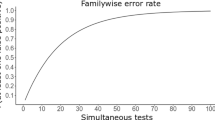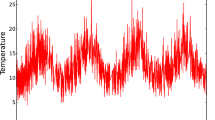Abstract
Ever wonder if it is possible to construct a numeric scale for environmental variables, like one does for the temperature? This paper is an attempt to construct one. There are two main parts: section “Statistical Analysis of Variations” presents a general statistical strategy for environmental factor selection. Section “Nonlinear Analytical Geometric Model of Variations” develops an analytical geometric representation of system variations in response to environmental changes. The model is used to quantify the effects of environmental interactions. The paper treats only one-dimensional case, however, the derivation of the case of multiple independent factors follows immediately. The general method developed in this paper may prove applicable to many different fields, such as extensions beyond classical physics, economics, and other sciences. Section “Conclusion” provides an illustration of applications, examples and implications of the results.
Similar content being viewed by others
References
Boltzmann, L. (1974). The second law of thermodynamics.
Bourbaki, N. (1969). Algebre linéaire et algebre multilinéaire.
Dehaene S., Spelke E., Pinel P., Stanescu R., Tsivkin S. (1999) Sources of mathematical thinking: Behavioral and brain maging evidence. Science 284: 970
Galton, F. (1897). Questions on the faculty of visions.
Iftime, M. D. (2010). Complex aspects of gravity, preprint available online on the Math. Phy., arXiv: 1001.4571v4.
Jordan K.E., Brannon E.M. (2006) A common representational system governed by Weber’s law: Nonverbal numerical similarity judgments in 6-year-olds and rhesus macaques. Journal of Experimental Child Psychology 95: 215–229
Kolesnikov S. I., Vinokurov V. A., Zaikov G. E., Kolesnikov I. M. (2001) Thermodynamics of spontaneous and non-spontaneous processes. Nova Science Publishers, New York
Kullback S. (1987) The Kullback—Leibler distance. The American Statistician 41: 4
La Geometrie. (1637). English edn, Dover (1978).
Landau L. D., Lifshitz E. M. (1977) The classical theory of fields. Elsevier, Amsterdam
Longo M. R., Lourenco S. F. (2007) Spatial attention and the mental number line: Evidence for characteristic biases and compression. Neuropsychologia 45: 7
Author information
Authors and Affiliations
Corresponding author
Rights and permissions
About this article
Cite this article
Iftime, M.D. A Nonlinear Method for Measuring the Effects of Environmental Variations. Found Sci 16, 353–361 (2011). https://doi.org/10.1007/s10699-011-9225-z
Published:
Issue Date:
DOI: https://doi.org/10.1007/s10699-011-9225-z




